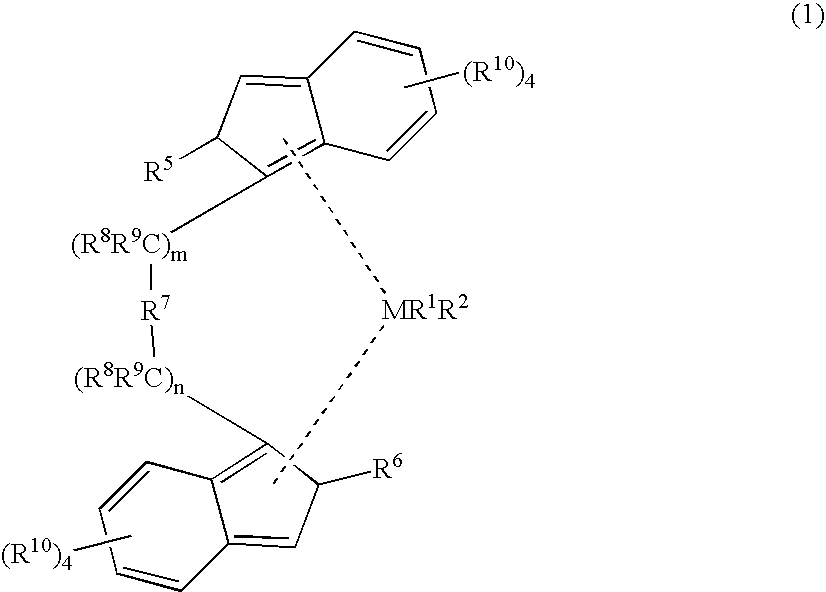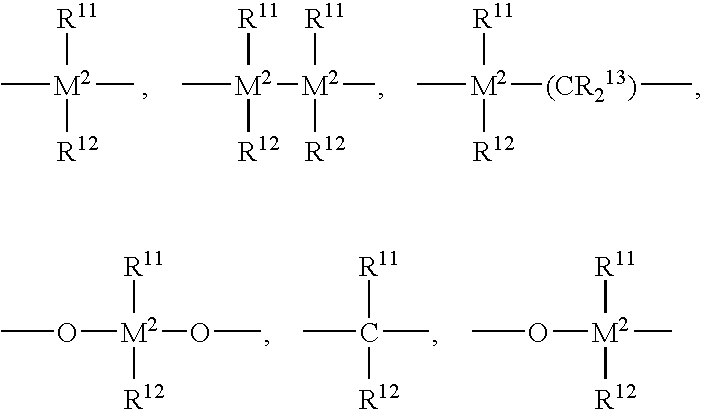Polypropylene fibers and fabrics
a polypropylene fiber and fabric technology, applied in textiles and papermaking, synthetic resin layered products, filament/thread forming, etc., can solve the problem of reducing the shot level, achieve good filtration properties, improve hydrohead and air permeability, and reduce the shot level
- Summary
- Abstract
- Description
- Claims
- Application Information
AI Technical Summary
Benefits of technology
Problems solved by technology
Method used
Image
Examples
##ventive example 1
Inventive Example 1
[0236]An inventive example, E1, of polypropylene used to make the fibers and fabrics, was prepared using a catalyst system comprising a metallocene on a silica support, either non-fluorided silica (“non-F”) or fluorided (“F”), and an NCA activator, such as described in U.S. Pat. No. 6.143,686. The catalyst system was prepared as generally described: rac-dimethylsilanedyl-bis(2-methyl-4-phenylindenyl)zirconium dimethyl and was combined with trisperfluorophenylboron in toluene (Albemarle Corporation, Baton Rouge, La.) and N,N-diethyl aniline. Separately, silica, either fluorided or non-fluorided, was added. The fluorided silica is described in WO 00 / 12565. A toluene solution of Kemamide™ AS 990 (8 g of AS 990 in 80 g toluene, C. K. Witco Corporation, Greenwich, Conn.) was added to the slurry before drying. Analysis typically shows a loading of 10 wt % Al, 0.20 wt % Zr and an Al / Zr molar ratio of 175.
[0237]Several batches of the catalyst system were combined to provi...
example 2
Comparative Resin Example 2
[0249]This (C2) is a Ziegler-Natta catalyzed polypropylene PP 3746G, obtained from ExxonMobil Chemical Company (Houston, Tex.).
example 3
Comparative Resin Example 3
[0250]This (C4) are Ziegler-Natta catalyzed polypropylene PP 3546G, obtained from ExxonMobil Chemical Company (Houston, Tex.).
[0251]The data in Table 1 reflects the high isotactic nature of the inventive resins. The data in Table 2 reflects the advantages in using the polymers of the invention when compared to either Ziegler-Natta (ZN) catalyzed polypropylene, or to comparative metallocene catalyzed polypropylene. The crystallization half-times of the inventive resins are improved over the comparative metallocene (C1) at the MFR shown in the Table 2. Further, the crystallization temperature (Tc) is higher for the inventive resin than for the comparative metallocene, which is an indication that the inventive resins will crystallize at a higher temperature during processing, which is advantageous. Finally, the second melt temperature (2d Tm) of the inventive resins is improved over the comparative metallocene resins, indicating the higher isotactic nature of...
PUM
| Property | Measurement | Unit |
|---|---|---|
| crystallization half time | aaaaa | aaaaa |
| diameter | aaaaa | aaaaa |
| crystallization half time | aaaaa | aaaaa |
Abstract
Description
Claims
Application Information
 Login to View More
Login to View More - R&D
- Intellectual Property
- Life Sciences
- Materials
- Tech Scout
- Unparalleled Data Quality
- Higher Quality Content
- 60% Fewer Hallucinations
Browse by: Latest US Patents, China's latest patents, Technical Efficacy Thesaurus, Application Domain, Technology Topic, Popular Technical Reports.
© 2025 PatSnap. All rights reserved.Legal|Privacy policy|Modern Slavery Act Transparency Statement|Sitemap|About US| Contact US: help@patsnap.com



